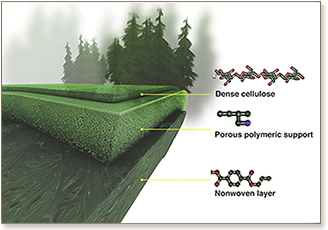Cellulose multilayer membranes manufacture with ionic liquid
S. Livazovic, Z. Li, A.R. Behzad, K.-V. Peinemann, S.P. Nunes
Journal of Membrane Science, Volume 490, Pages 282–293, (2015)

Membrane processes are considered energy-efficient for water desalination and treatment. However most membranes are based on polymers prepared from fossil petrochemical sources. The development of multilayer membranes for nanofiltration and ultrafiltration, with thin selective layers of naturally available cellulose has been hampered by the availability of non-aggressive solvents. We propose the manufacture of cellulose membranes based on two approaches: (i) silylation, coating from solutions in tetrahydrofuran, followed by solvent evaporation and cellulose regeneration by acid treatment; (ii) casting from solution in 1-ethyl-3-methylimidazolum acetate ([C2mim]OAc), an ionic liquid, followed by phase inversion in water. By these methods porous supports could be easily coated with semi-crystalline cellulose. The membranes were hydrophilic with contact angles as low as 22.0°, molecular weight cut-off as low as 3000 g mol−1 with corresponding water permeance of 13.8 L m−2 h−1 bar−1. Self-standing cellulose membranes were also manufactured without porous substrate, using only ionic liquid as green solvent. This membrane was insoluble in water, tetrahydrofuran, hexane, N,N-dimethylformamide, 1-methyl-2-pyrrolidinone and N,N-dimethylacetamide.